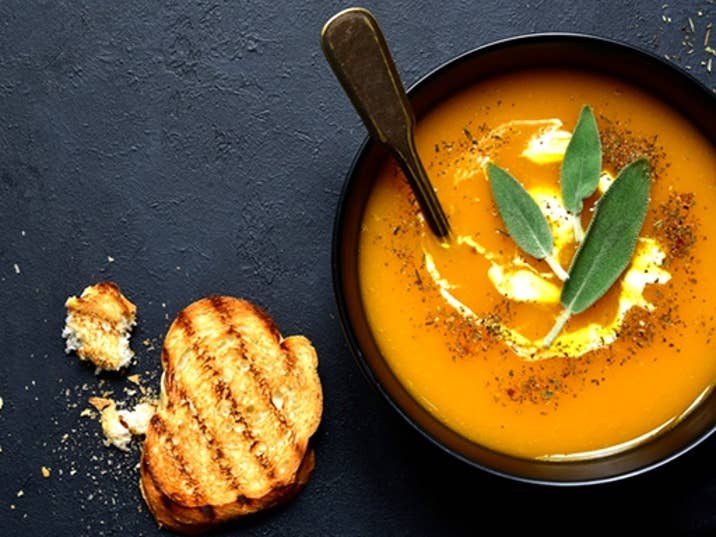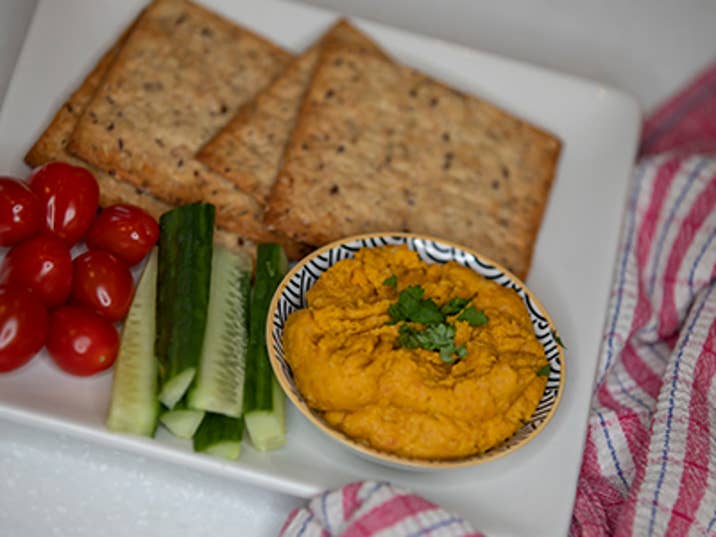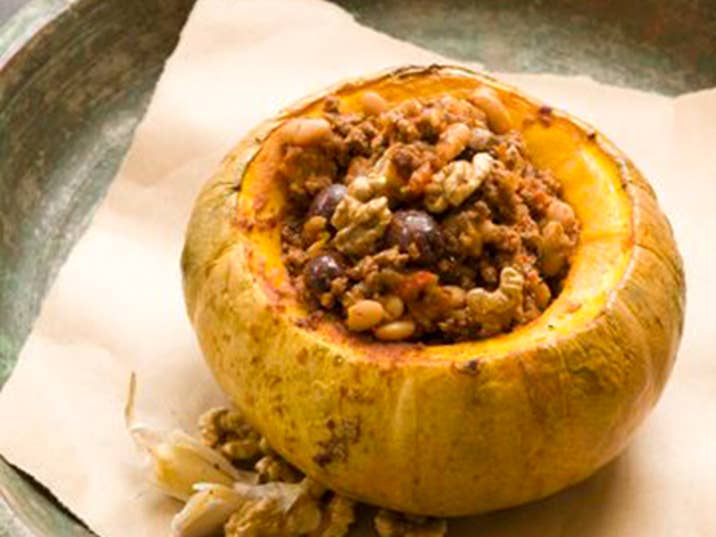Types of pumpkins and how to eat them
Pumpkin and winter squash
6 types of pumpkin and squash, plus how to buy, store and cook them.
The pumpkin plant is a member of the cucurbitaceae family. Pumpkins are hard skinned, firm fleshed, mature fruit. In New Zealand, they're grown as an annual crop, planted in Spring and harvested in Autumn, just in time to enjoy a wide range of warm, comforting winter recipes. Pumpkin keeps well, so is available instore all year round in New Zealand. You'll find that the names 'pumpkin' and 'squash' are used interchangeably, just as the varieties are interchangeable in cooking.
Is Pumpkin a fruit or a vegetable?
Main types of pumpkin in New Zealand
Winter pumpkin season in New Zealand, offers a diverse range of pumpkin and squash. Below are the most popular varieties to be found in your supermarket or fresh produce store.
1. Crown grey pumpkin
Season: Available from February to December (with limited availability in January). Crown pumpkin is distinguished by its unusual blue/grey skin colour which dramatically contrasts with its deep orange flesh. They are one of the larger New Zealand grown varieties, averaging approximately 30cm in diameter and weighing up to 4kg. Their hard skin helps protect the pumpkin whilst being stored and they are usually available all year round. You can buy crown grey pumpkins whole, portioned and as a convenient canned pumpkin.

2. Butternut squash
Season: Available from February to November (with limited availability in February).
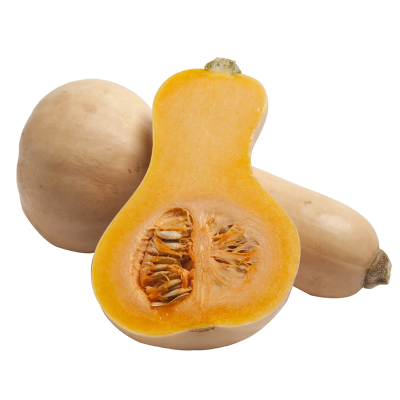
Butternut squash has a very distinctive, elongated pear shape and is considerably smaller than a Crown pumpkin, so is generally sold whole. The skin is a warm, beige colour with a bright orange flesh. Butternut pumpkin has fewer seeds and below we reveal how you can roast pumpkin seeds. The sweetest variety of winter pumpkins, butternut squash is perfect for roasting, pan frying in a risotto, or making pumpkin soup and a smooth, silky puree.
3. Buttercup pumpkin
Season: Available from January to November (with limited availability in February).

Buttercup squash are small, just 15-20cm in diameter, round and squat shaped with a round ridge on the bottom which is sometimes referred to as a turban. Buttercup pumpkins have a dark green skin marked with grey or green vertical markings which is often softer than other squash. Inside, the buttercup's vibrant orange flesh is firm and dense in texture, making it perfect for slow cooked vegetable curries and pumpkin casseroles.One of the sweeter winter squash, Buttercup's texture is smooth and creamy when cooked and is perfect for a pumpkin puree.
4. Spaghetti squash
Season: Available all year round.
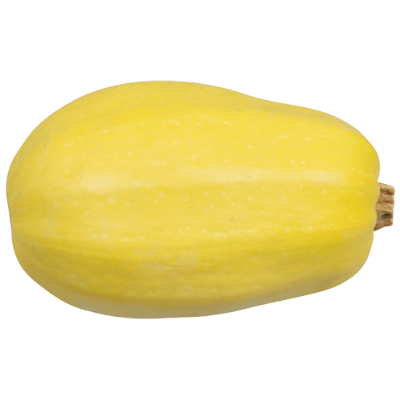
This bright yellow, cylindrical shaped squash gets its name from the flesh, which when cooked develops strands that look like spaghetti. You can eat it as a gluten free substitute for spaghetti but it doesn't actually taste like spaghetti. You can roast or steam spaghetti squash, then scrape out the strands into a bowl and cover with a sauce, pesto or bolognese. Eat it just like pasta, the texture is tender and a little chewy. Less sweet than other squash and pumpkin, it's an excellent squash to incorporate into savoury dishes.
5. Kabocha Squash
Season: Available from January to April
Kabocha is an Asian variety of winter squash. Kabocha are small pumpkins which are round and squat in shape. Kabocha is a hearty squash which eats like a fluffy sweet potato. It tastes like a cross between a pumpkin and a sweet potato, with its sweet earthy flavour and hints of chestnut. Kabocha squash have fewer calories than butternut squash and are full of beta-carotene and fibre.
6. Kamokamo pumpkin/Kumi Kumi
Season: Available from December to April
Kamokamo is classified as a native heritage vegetable that grows on the vine here in New Zealand. This heavily ribbed pumpkin is green when young, round in shape and about the size of a tennis ball. Once ripe Kamokamo more closely resembles the size of a netball. Its skin changes to a warm orange colour and inside, its soft orange flesh has a deliciously nutty flavour. Believed to have arrived with Māori in the 19th century, Kamokamo are still grown and enjoyed by Maori, who cook it in a similar way to courgettes and marrow.
Canned, frozen or fresh pumpkin?
Fresh, canned and frozen pumpkin all have very similar levels of vitamins and nutrients.
The main differences between them is the flavour and texture.
Fresh pumpkin
Fresh pumpkin can have the best flavour providing it has been refrigerated once cut (see ‘Buying and storing pumpkin’ below). Like most fresh vegetables, it has the firmest texture (when raw) giving you more control over the overall texture once cooked. This makes it ideal for roasting, mashing etc.
Canned pumpkin
Canned pumpkin is slow-cooked giving it a deeper, more robust, flavour. As it is a puree, it is ideal for baking.
Frozen pumpkin
Frozen pumpkin tastes like fresh pumpkin once it has been cooked but, like other frozen vegetables, it can be watery if you don’t drain it. As freezing softens the pumpkin's texture, frozen pumpkin is best mashed, blended or cooked down.
Find our more fresh versus frozen vegetables.
Buying and storing pumpkin
Fresh pumpkin can be bought whole or cut into halves or quarters. Whilst whole, pumpkin can remain at room temperature, however, once cut it needs to be refrigerated.
Look for a squash or pumpkin that feels heavy for its size. Select one that has an evenly coloured skin, it should be spot and blemish free. Avoid any with cracks or soft spots
Pumpkin stores well at normal room temperature until it is cut. Once you have cut the pumpkin, remove all of the seeds immediately, wrap in plastic film and refrigerate.
Preparing and cooking pumpkin
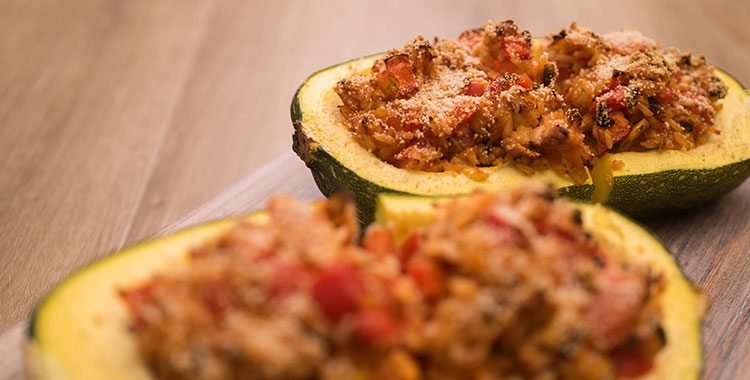
Cutting into a pumpkin
Can you eat the skin?
Roasted pumpkin is delicious
Another simple way to bring out the pumpkin's natural flavour, is to spread the chunks over a baking tray, drizzle with olive oil then add salt and lightly spice with sage and thyme or cumin and coriander, both great combinations.
Bake in a hot oven for 20-30 minutes until the pumpkin is tender and it smells like sweet caramel. You can then enjoy:
- As a vegetable side dish with a roast dinner.
- Serve tossed in a winter salad for lunch.
- In a delicious pumpkin gnocchi or pumpkin risotto.
- As a savoury filling for pumpkin ravioli.
- When boiled or roasted, pumpkin makes a wonderful mash, finished by tossing it with salty butter and black pepper.
Roast pumpkin makes a delicious side for a juicy roast leg of lamb rounding out a classic Kiwi roast dinner.
Use squash in your baking
You might be surprised to know that in botanical terms, pumpkin and squash are classed as a fruit and not a vegetable. When growing, the plants bear flowers which develop into the seed containing fruit. In nutritional and culinary terms, pumpkins, gourds and squash are universally regarded as a vegetable and eaten as one.
Butternut squash has a very distinctive, elongated pear shape and is considerably smaller than a Crown pumpkin, so is generally sold whole. The skin is a warm, beige colour with a bright orange flesh. Butternut pumpkin has fewer seeds and below we reveal how you can roast pumpkin seeds. The sweetest variety of winter pumpkins, butternut squash is perfect for roasting, pan frying in a risotto, or making pumpkin soup and a smooth, silky puree.
This bright yellow, cylindrical shaped squash gets its name from the flesh, which when cooked develops strands that look like spaghetti. You can eat it as a gluten free substitute for spaghetti but it doesn't actually taste like spaghetti. You can roast or steam spaghetti squash, then scrape out the strands into a bowl and cover with a sauce, pesto or bolognese. Eat it just like pasta, the texture is tender and a little chewy. Less sweet than other squash and pumpkin, it's an excellent squash to incorporate into savoury dishes.
Kabocha is an Asian variety of winter squash. Kabocha are small pumpkins which are round and squat in shape. Kabocha is a hearty squash which eats like a fluffy sweet potato. It tastes like a cross between a pumpkin and a sweet potato, with its sweet earthy flavour and hints of chestnut. Kabocha squash have fewer calories than butternut squash and are full of beta-carotene and fibre.
Kamokamo is classified as a native heritage vegetable that grows on the vine here in New Zealand. This heavily ribbed pumpkin is green when young, round in shape and about the size of a tennis ball. Once ripe Kamokamo more closely resembles the size of a netball. Its skin changes to a warm orange colour and inside, its soft orange flesh has a deliciously nutty flavour. Believed to have arrived with Māori in the 19th century, Kamokamo are still grown and enjoyed by Maori, who cook it in a similar way to courgettes and marrow.
Cutting into the firm skin and flesh can be a challenge. Ensure you have a really sharp knife and enter vertically, close to the centre crown. Move the knife down so it is sitting horizontally. Remove the knife and repeat on the other side of the crown. If you find this too difficult you can roast the pumpkin whole and slice open once soft - or you can buy pumpkin which is precut for you.
The skin of the pumpkin is edible, healthy and really delicious. Just make sure to give it a good scrub before cooking.
Pumpkin is so good for us and it should never be wasted. Leftovers can be incorporated into sweet cakes, scones, muffins and even bread.
Pumpkin seeds
Don't eat raw pumpkin seeds. Raw pumpkin seeds may increase your risk of food poisoning. Always cook pumpkin seeds at a high temperature before eating, to prevent this happening.
How to remove pumpkin seeds from the pulp
When you scoop the seeds out with a strong metal spoon, it can be difficult to separate the pumpkin seeds from the sticky residue. Place the pulp in a bowl of cold water and any loose seeds will float to the top. Using your fingers, gently loosen the remaining seeds from the pulp, which can then be composted.
Roasted pumpkin seeds
Pumpkin seeds nutrition information
The seeds of pumpkin and squash are a good source of so many nutritional vitamins and minerals. They can be purchased in packets for a healthy snack or sprinkled onto dishes to add texture and crunch.
- Magnesium: Pumpkin seeds are one of the best natural sources of magnesium, which is important for heart and bone health and to control blood pressure and blood sugar levels in the body.
- Antioxidants: Full of antioxidants, pumpkin seeds can help protect against chronic diseases, some cancers and inflammation.
- Fibre: A good source of dietary fibre, pumpkin seeds are associated with a reduced risk of heart disease, diabetes and obesity.
- Zinc: The high zinc content of pumpkin seeds can improve sperm quantity and male fertility.
- Tryptophan: The tryptophan, zinc and magnesium in pumpkin seeds can help you to get a good night's sleep.
- Enzyme inhibitor: Did you know that pumpkin seeds can help with an overactive bladder (OAB)? They inhibit 2 enzymes, which slow down prostrate growth and increase testosterone levels in men and strengthen a woman's pelvic floor.
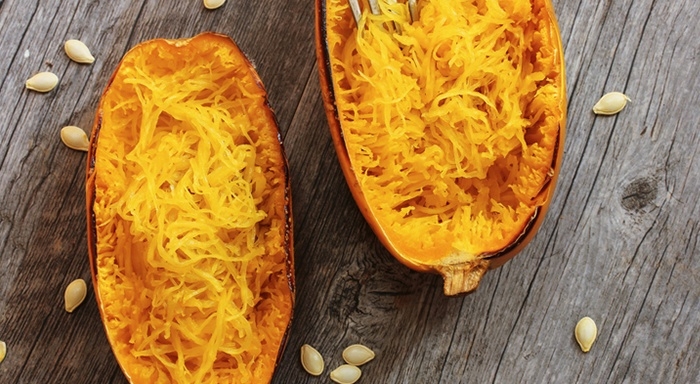
Health benefits of pumpkin
1. Pumpkin can lower the risk of age related sight loss
2. Pumpkin can lower your risk of cancer
3. Pumpkin can assist with weight loss
4. Pumpkin can benefit heart health
5. Pumpkin boosts immunity
6. Pumpkin is great for your skin
Who shouldn't eat pumpkin?
Enjoy fresh seasonal pumpkins
seasonal fruits and vegetables herePumpkin seeds are the edible seeds of pumpkin and squash. They're typically flat and oval and have a white outer husk, which once removed reveals the seeds light green colour. Pumpkin seeds are nutritionally valuable in their own right so don't just discard them.
First allow the clean pumpkin seeds to dry at room temperature. Toss them in a little olive oil, chilli powder and seasoning and spread out onto a lined baking tray. Roast the seeds at a high temperature in the oven for approximately 15 minutes.
Eating pumpkin is recommended by wellness professionals for a wide host of health benefits.
Pumpkin is one of the best dietary sources of lutein and zeaxanthin, which can reduce your risk of developing age related macular degeneration. Its high levels of Vitamin A and beta-carotene significantly lowers your risk of cataracts.
Pumpkins are a good source of carotenoids, which act as antioxidants in the body, neutralising free radicals that encourage abnormal cells to multiply. Scientists have linked antioxidants to a reduced risk of stomach, throat, pancreatic and breast cancers.
If you're on a weight loss program, you can eat pumpkin freely. Pumpkin is a nutrient dense food, meaning it's full of nutrients and just 50 calories per cup. As a good source of dietary fibre, pumpkin can also suppress the appetite so you don't overeat.
High in potassium, vitamin C and fibre, pumpkin has been linked to improvements in our heart health.
Pumpkin's high levels of Vitamin A, C and E, when combined with its folate and iron content, can strengthen your immune system and protect you from viruses.
Pumpkin is very high in beta-carotene which research shows, when converted to vitamin A, can act as a natural sunblock. Vitamins C and Vitamin E, lutein and zeaxanthin also help to strengthen the skin.
Pumpkin is mildly diuretic and can work in a similar way to a water pill. This process may harm people who take medicines such as lithium. Allergies to pumpkin are rare and can cause an itchy rash and allergic reactions in some people. Pumpkin and squash should be avoided by anyone with a pumpkin allergy.
Now you know how wonderfully healthy pumpkins are, we hope you'll enjoy them even more. Try incorporating pumpkin into your daily diet and discover just how versatile and delicious they are. Find out more about other
.
Read more Fruit and Vegetable guides
Pumpkin | Kumara | Silverbeet | Asparagus | Watermelon | Afourer Mandarin | Cherry Tomato | Mushrooms | Avocado | Grapefruit | Broccoli | Celery | Potatoes | Oranges | Strawberries
